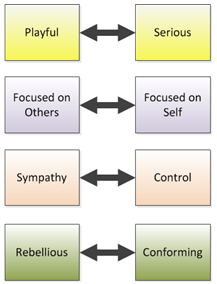Can Reversal Theory Inform Design Work?
Sunday, January 27th, 2013About three years ago in my Cognitive Design class at Northwestern a small group of students focused on applying insights from reversal theory to hard design problems. They used it as a way to model motivational states – one of the four psychology states (motivational, affective, intellectual and volitional) we study in cognitive design.
 The idea behind reversal theory is that human motivations are complex and often conflicting. We can model motivation in terms of four types of states and how we switch or reverse our positions on each. The four states include how we are:
The idea behind reversal theory is that human motivations are complex and often conflicting. We can model motivation in terms of four types of states and how we switch or reverse our positions on each. The four states include how we are:
1. playful or serious
2. other or self-focused
3. focused on control or sympathy
4. conforming or challenging.
Our motivation in any given context can be explained as a mixture of these four states. Changes in our motivation are caused by reversals in any one of the states. For example when we go from playful to serious or from sympathetic to controlling. They shape the meaning we assign to events and objects which in turn generate emotions such as enjoyment, communal feeling, caring and a sense of freedom.
Michael Apter, a leading researcher in reversal theory goes farther emphasizing the central role of motivation in determining emotion:
“But to the extent to which designers deliberately attempt to induce emotions, they typically overlook the fact that emotions arise only through motivations, each emotion representing a desirable or undesirable way of experiencing a particular motivation. Reversal theory has the potential to provide a framework for design by identifying ways in which ‘things’ (in the most general sense) induce motivational states. “
To bring it to a sharper point, as cognitive designers we can consider features and functions that trigger a reversal in any of the four mental states described above.
For a designer friendly introduction check out the reversal theory training site.